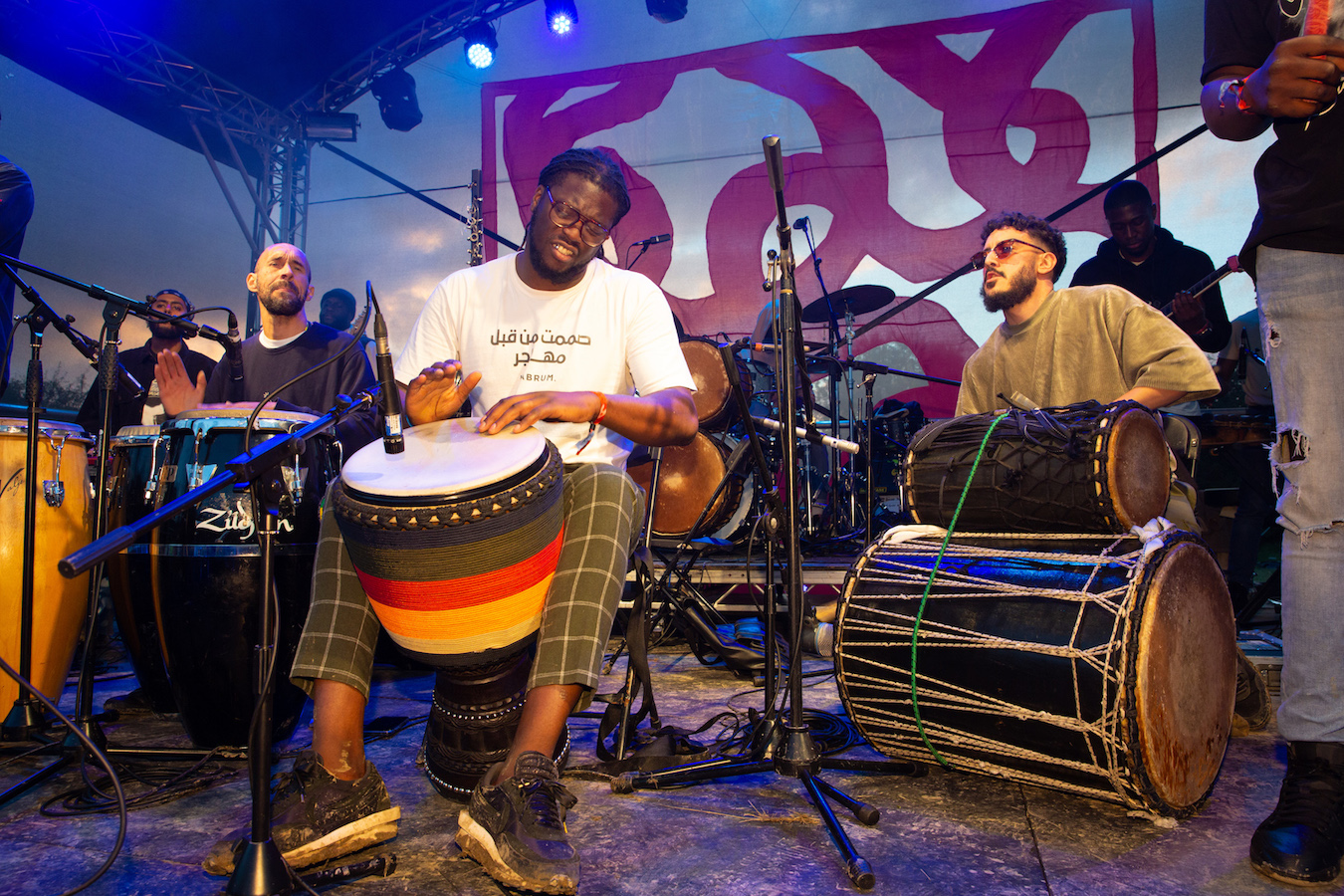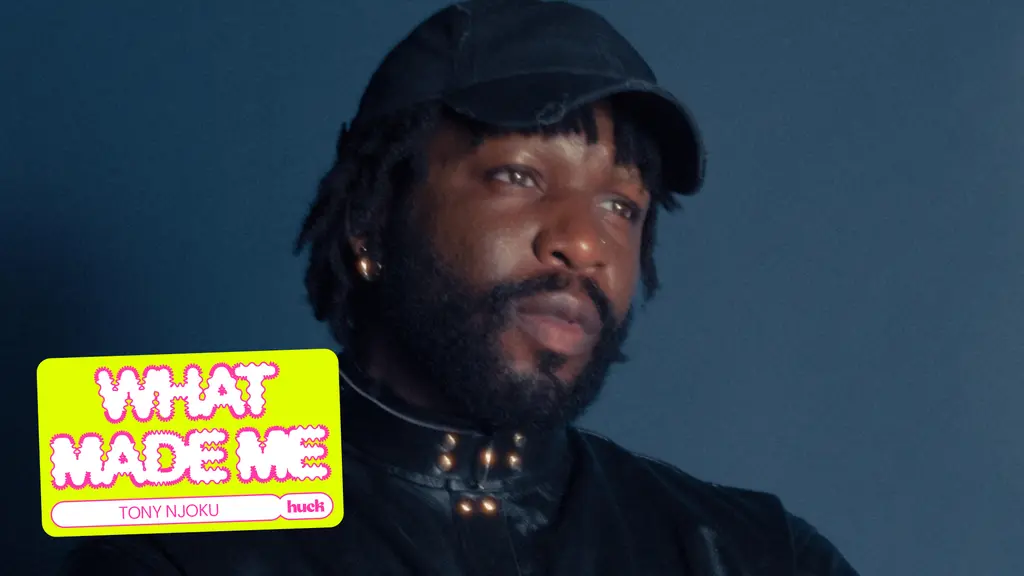How Brainchild defied the odds with this year’s festival
- Text by Ben Smoke and Daisy Schofield
- Photography by Lava La Rue by Dominic Markes

“There’s so much to say about Brainchild this year,” begins the caption on an Instagram post by the festival’s creative director, Marina Blake. “Some of it’s so bad you’ve got to laugh, and some of it’s so bad you’ve got to cry, and some it’s so beautiful you have to cry again. It’s basically a lot.”
It is, perhaps, the perfect summary of the long-awaited return of the festival, following the forced cancellation of last year’s iteration due to the pandemic. To say it’s been a tumultuous time for events and festival organisers, artists, musicians and performers would be to drastically undersell the torture of the last 18 months. The mental toll suffered by people working in the live events industry following the closure of venues was something we covered in Huck in May of last year. This was before the weight of the second wave crashed down upon the country, and thrust the industry into further turmoil.
There is much to be said about the dearth of government support received by events and festivals. Such was the uncertainty caused by changing goalposts and lack of material support (such as cancellation insurance), that many bigger festivals had no choice but to cancel. For Brainchild, who were not awarded Arts Council support, this year’s festival was only possible through a 50 per cent crowd cover pledge which saw ticket holders accept some of the financial risk of putting on the event. Had the event been forced to cancel because of changing Coronavirus restrictions, ticket holders would only get a refund of 50 per cent.

Photo credit: Annie Tobin
It meant an unprecedented buy-in by festival attendees, which spoke to the core of what, or who, Brainchild is. A DIY festival pulled together by friends with no major financial backing that has only grown year on year since the first iteration of the event back in 2012, gathering around it a community of devoted fans eager to get back into the fields.
Even before it had begun, this summer had all but buckled under the weight of the expectation hung upon it. We were to have the biggest and the best of all hot girl summers. An antidote to the year of misery, loss and sacrifice that had preceded it. In many ways, there was no way it could ever meet those expectations. Brainchild, perhaps in some ways, fell victim to this phenomenon.

Balimaya on the Brainstage. Photo credit: Dominic Markes
The festival, which normally takes place in the hot and heady climbs of mid-July was shifted to the beginning of August and was plagued by heavy downpours that saw the site transformed into a mud pit. “It felt like we’d got two strides away from the joyful and victorious finish line of a marathon to get the festival on, and someone came in from the wings and decked us to the ground,” Blake’s post-festival Instagram post continued. “This may sound dramatic but it really was that bad. It was extreme flash flooding wash out, the landowners had seen nothing like it in all their years and the land revealed its terrible drainage – unbeknownst to us or them.”
Where normally, there would be groups of people lounging in the sun, morning yoga, packed out tents with attendees sat together on the ground taking in talks, there was mud and slush. It felt, at points, apocalyptic. It wasn’t the return to the fields that anyone had planned for but, perhaps, it was the most fitting round off to the year that had come before.
Among the mud and the sludge, there was an abundance of joy. There was laughter and happiness. Revelry and hedonism painting ever sodden step, jump or dance. There was a collectiveness in the chaos of the great British summer. Shining, beautiful moments of jubilation made even sweeter by the mud and the dirt and the grime. Huck was there to experience it all, and we gathered some of the highlights together for you below.
Music
Friday saw the fields flooded with arrivals. As tents were hurriedly pitched and pints sourced with equal urgency, the festival erupted into life, with music playing out across seven stages and tents.
Brainchild offers a full suite of music, from DJs, bands, singer songwriters and more: year on year the bill is packed with a whole smattering of offerings, and this year was no exception. Friday night headliners Overmono delivered a transcendental performance. The UK electronic duo filled the night sky with lasers and beats, pulling together a pulsating crowd of revellers, eager to forget about the year that had been. An extended version of their remix of For Those I Love’s ‘I Have a Love Were’ perhaps the highlight of their set – a moment of sheer elation and joy that punches through even the haziest of memories of the night.
Across the weekend, other highlights included Lava La Rue’s sunset slot on the Brainstage. The west Londoners twisting beats and lyrics lifting the audience far above the mud and the grime to dance in a queer wonderland. South London’s Lemon Lounge collective brought the party across Friday and Saturday, with ahadadream‘s Saturday night closing set seeing densely packed crowds undulating to a rising crescendo.

ahadadream’s set at the Lemon Lounge. Photo credit: Dominic Markes
On Sunday, the Festival’s Kite Bar played host to Queer House Party: a collective who started in the pandemic as an online space to keep the party – and more importantly community – going as we were locked down. The sheer force of dancing managed to break the stage as they dropped Azealia Bank’s ‘212’ – perhaps no better summation of the power of their set.
Through the weekend, late into each night, it was possible to stumble into a stage, a wooded clearing or tent and see people dancing and jumping together, revelling in one another and the spaces the artist and festival carved out.

Queer House Party. Photo credit: Karla Hunter
Artwork
This year, the artwork brought a welcome splash of colour and fantasy amid the mud. Highlights included Annie-Rose Fiddian-Green’s largest installation to date, a giant hexagonal light box decorated with a colourful painted mural of dancing figures and animals. Speaking about the project, she said: “It was inspired by the importance of touch and unity after such a time of separation. But also how we remain interconnected no matter the rules and oceans that can part us. The painting expresses bodily freedom, the importance of self love, unity, and celebration.”

‘Wrap Your Arms Around Me’ by Annie-Rose Fiddian-Green. Photo credit: Karla Hunter
In the woods, which usually plays host to the festival’s late-night revellers, Beccy McCray’s psychedelic, human-sized termite mounds, made for an eye-catching display. “Taken into the context of the natural world, these alien totems remind us of standing stones, mystical fungus or cacti, flowing lava and stalagmites, alive and hinting at other worlds,” said Beccy about the work. “Is it the end of the party – or is it just the beginning?”

Credit: @beccy_mccray via Instagram
Talks
The Politics of Imagination
Lola Olufemi, author of Feminism, Interrupted (Pluto Books), and multidisciplinary artist Jacob V Joyce delivered a rousing speech on how the ability to imagine other futures is fundamental to building a better world. Speaking about the power of the imagination in political organising, Olufemi said: “If we are broadly on the left, we lose a lot. And I think the imagination is an important way for us to understand, actually, the walls that we seek to build are much bigger than a simple win or loss; they’re beyond what we can even conceive of.” She spoke about “the scarcity logic” built into capitalism, which prevents us from realising that we do have enough – it’s about envisaging the “distribution of resources when it comes to things like housing and money and so on”. The talk also considered Joyce’s artistic practice, and how their creation of a mural to commemorate the 1981 Brixton riots was used to amplify radical Black histories through a learning resource.
Daytimers
Since forming in 2020 at the beginning of the pandemic, Daytimers have quickly made waves on the UK party scene. The collective is made up of DJs from all corners of the UK, with one member living across the pond in New Jersey. Their talk at Brainchild centred on the heritage of their name: that being, the day time parties of the ’80s and ’90s where young British Asians gathered to dance to bhangra, garage and jungle. Many young British Asians who came of age during these decades were looking for ways to escape their conservative parents who, on the whole, disapproved of their children going to nightclubs and engaging in the hedonism that comes with it. These events took place not at night but during the afternoon, when those kids were thought to be at college, school or the library – hence why they were christened ‘daytimers’.

Daytimers performing at Brainchild. Photo credit: Kieran Dhanjal
Understanding Endometriosis
Ellie Pearce gave a vital talk on living with endometriosis – a condition impacting 10 per cent of women. It detailed how to recognise and cope with the symptoms, and dealing with dismissive doctors to get a diagnosis. Through an accompanying textile installation titled ‘Insides Out’ created by Ellie, the intention was to use art as a catalyst for conversations about the invisible, inner-workings of our bodies and chronic pain.

Pictured: Installation by Ellie Pearce. Photo credit: Annie Tobin
To find out more about Brainchild visit their official website.
Enjoyed this article? Like Huck on Facebook or follow us on Twitter.
You might like

Nina Utashiro builds disquieting, macabre sonic worlds
Huck x Eastern Margins — We caught up with the Japanese-German rap experimentalist ahead of her performance at Huck’s SXSW London joint event with Eastern Margins.
Written by: Isaac Muk

Huck teams up with Eastern Margins for a special SXSW London showcase
From Shibuya to Shoreditch — Taking place at Village Underground on Monday, performances will come from MONO, Nina Utashiro, Ena Mori, Jianbo, LVRA & Soda Plains.
Written by: Isaac Muk

Analogue Appreciation: Shura
I Got Too Sad For My Friends — In an ever more digital, online world, we ask our favourite artists about their most cherished pieces of physical culture. Today, it’s English singer-songwriter Shura.
Written by: Shura

After Assad’s fall, Syria’s musicians rebuild from the rubble
Spaces Between the Beats — Following decades of dictatorship and 14 years of civil war, the country’s classical and creative scenes have an opportunity to build from scratch. Andrei Popviciu speaks to the people hoping for a flourishing new era of art and sound.
Written by: Andrei Popoviciu

Tony Njoku: ‘I wanted to see Black artists living my dream’
What Made Me — In this series, we ask artists and rebels about the forces and experiences that shaped who they are. Today, it’s avant-garde electronic and classical music hybridist Tony Njoku.
Written by: Tony Njoku

Jack Johnson
Letting It All Out — Jack Johnson’s latest record, Sleep Through The Static, is more powerful and thought provoking than his entire back catalogue put together. At its core, two themes stand out: war and the environment. HUCK pays a visit to Jack’s solar-powered Casa Verde, in Los Angeles, to speak about his new album, climate change, politics, family and the beauty of doing things your own way.
Written by: Tim Donnelly

